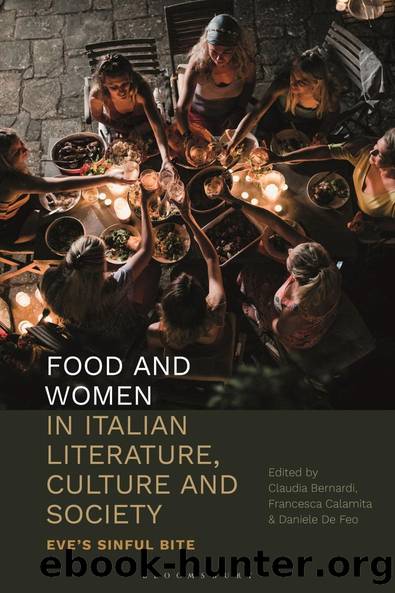Food and Women in Italian Literature, Culture and Society by unknow

Author:unknow
Language: eng
Format: epub
Tags: Fiction & Literature, Literary Theory & Criticism, Nonfiction, Social & Cultural Studies, Social Science
ISBN: 9781350137806
Publisher: Bloomsbury Publishing
Published: 2020-11-12T05:00:00+00:00
11
Writing food
Issues of female identity and gender politics in Dacia Marainiâs novels
Maria Morelli
By her own admission, Dacia Marainiâs âobsessionâ with food dates back to her traumatic experience of the Japanese concentration camp for anti-fascists where she was interned with her family during the Second World War, an experience she has recounted in her autobiographical account of her childhood years, La nave per Kobe: diari giapponesi di mia madre (The Boat to Kobe: My Motherâs Japanese Diaries, 2001).1 The hunger she suffered then, as a small child, inevitably shaped her aesthetic and literary imagination. Food â or lack of it â has become a quasi-ubiquitous motif in her writings.2
Womenâs predilection for food imagery and symbolism in literary works has been a growing interest for scholars at least since the 1980s. For Hélène Cixous, food is central to womenâs relationship with their corporeality, as well as with their culture. Taking the âscene of the appleâ as recounted in Genesis as a starting point for her argument, in âExtreme Fidelityâ (1988), Cixous contends that Eveâs story is that of every woman, constantly negotiating the cultural taboos that the patriarchal law has inscribed onto the surface of her body. Albeit addressing the relationship between women and food in strictly psychoanalytical terms, in The Hungry Self: Women Eating, and Identity (1985), Kim Chernin reaches a similar conclusion, positing eating habits â and conformance to, or denial of, maternal teachings about them â as the most obvious factor in shaping womenâs identity. This connection between food and what it entails (housework, childbearing and childrearing) and female identity became all the more obvious with the womenâs movement, when expectations about domesticity and foodwork were challenged by the feminist critique of the myth of the âhappy housewifeâ.3 Women began to question their role as nurturers â food purveyors, that is â and to explore the implications of conforming to a traditional, patriarchal script.
In this chapter, I will analyse the recourse to food imagery in a number of Marainiâs works belonging to what critics have usually identified as her most explicit feminist phase: Donna in guerra (Woman at War, 1975), Lettere a Marina (Letters to Marina, 1981), Il treno per Helsinki (The Train to Helsinki, 1984), all texts where images of food, or what it stands for, are too pervasive to be merely coincidental. Looking at both levels of representations â the literal and the symbolic â I will argue that in these writings, the act of preparing, presenting or consuming meals, while reaffirming food as central in the shaping of the female experience, also bespeaks the authorâs preoccupations with an essentialist model of female identity that casts women in the role of carers, the very same preoccupation that feminism had for the first time brought to the fore.
Donna in guerra tells the story of a meek and compliant primary school teacher, Vanna (Vannina) Magro, and her path towards self-awareness and emancipation from patriarchal expectations and a constrictive marriage. Heralded by many as Marainiâs most overt feminist novel, it reflects the authorâs concern towards domesticity against a backdrop of changing cultural values.
Download
This site does not store any files on its server. We only index and link to content provided by other sites. Please contact the content providers to delete copyright contents if any and email us, we'll remove relevant links or contents immediately.
1610396766 (N) by Jo Ann Jenkins(1296)
Elizabeth Is Missing by Emma Healey(1229)
McGraw-Hill Nurses Drug Handbook by Patricia Schull(1182)
Cherry Ames Boxed Set, Books 1 - 4 by Helen Wells(1151)
Economics and Financial Management for Nurses and Nurse Leaders, Third Edition by Susan J. Penner RN MN MPA DrPH CNL(1142)
The Language of Kindness by Christie Watson(1116)
Cherry Ames, Student Nurse by Helen Wells(1098)
NCLEX-RN Prep Plus 2019 by Kaplan Nursing(1095)
Spiritual Midwifery by Ina May Gaskin(1079)
Whoever Tells the Best Story Wins: How to Use Your Own Stories to Communicate with Power and Impact by Annette Simmons(1056)
Cherry Ames Boxed Set, Books 5 - 8 by Helen Wells(1048)
Home. by Sarah Graham(1047)
Cracking the Nursing Interview by Jim Keogh(1023)
1476763445 by Liz Fenton(1002)
Dementia by June Andrews(927)
Getting Started with Arduino by Massimo Banzi(919)
Cherry Ames, Army Nurse by Helen Wells(897)
Shadows of the Workhouse: The Drama of Life in Postwar London by Jennifer Worth(886)
Children's Medicines by Edward A. Bell(882)
